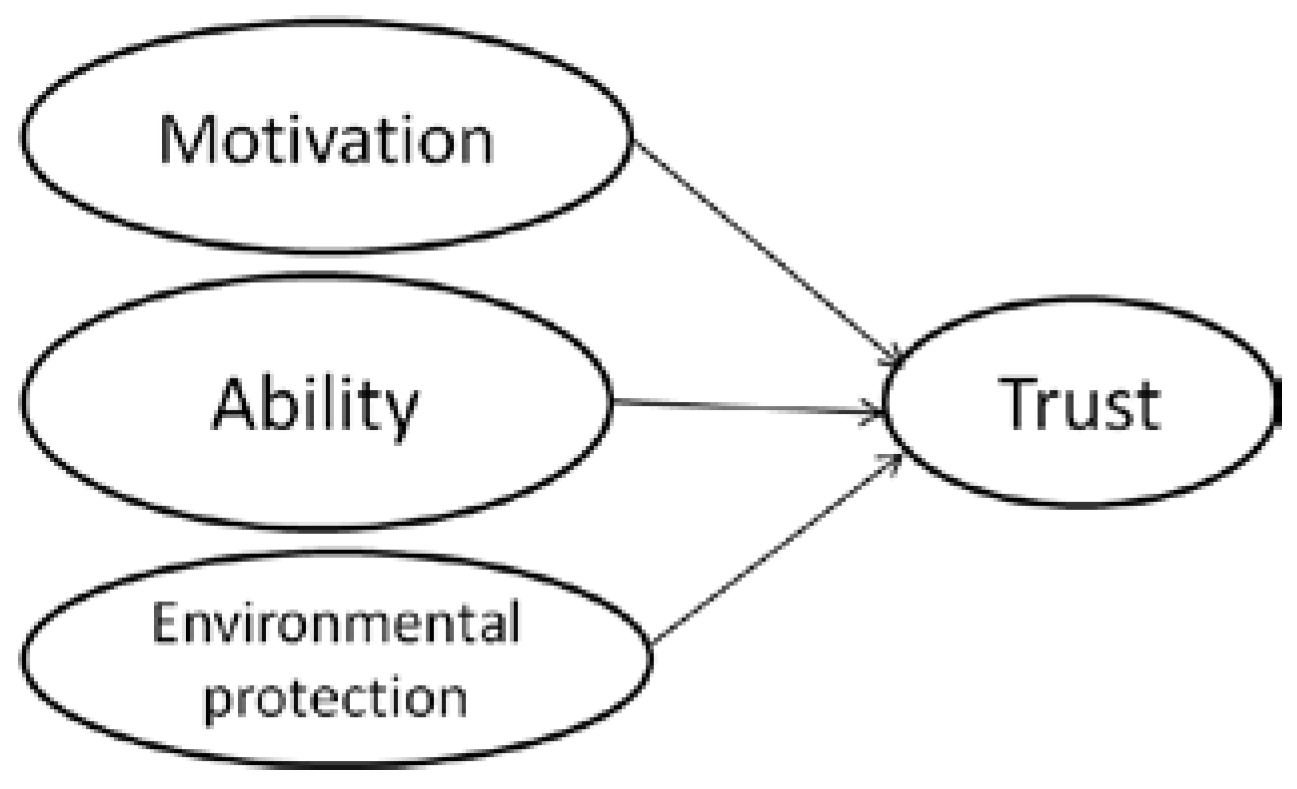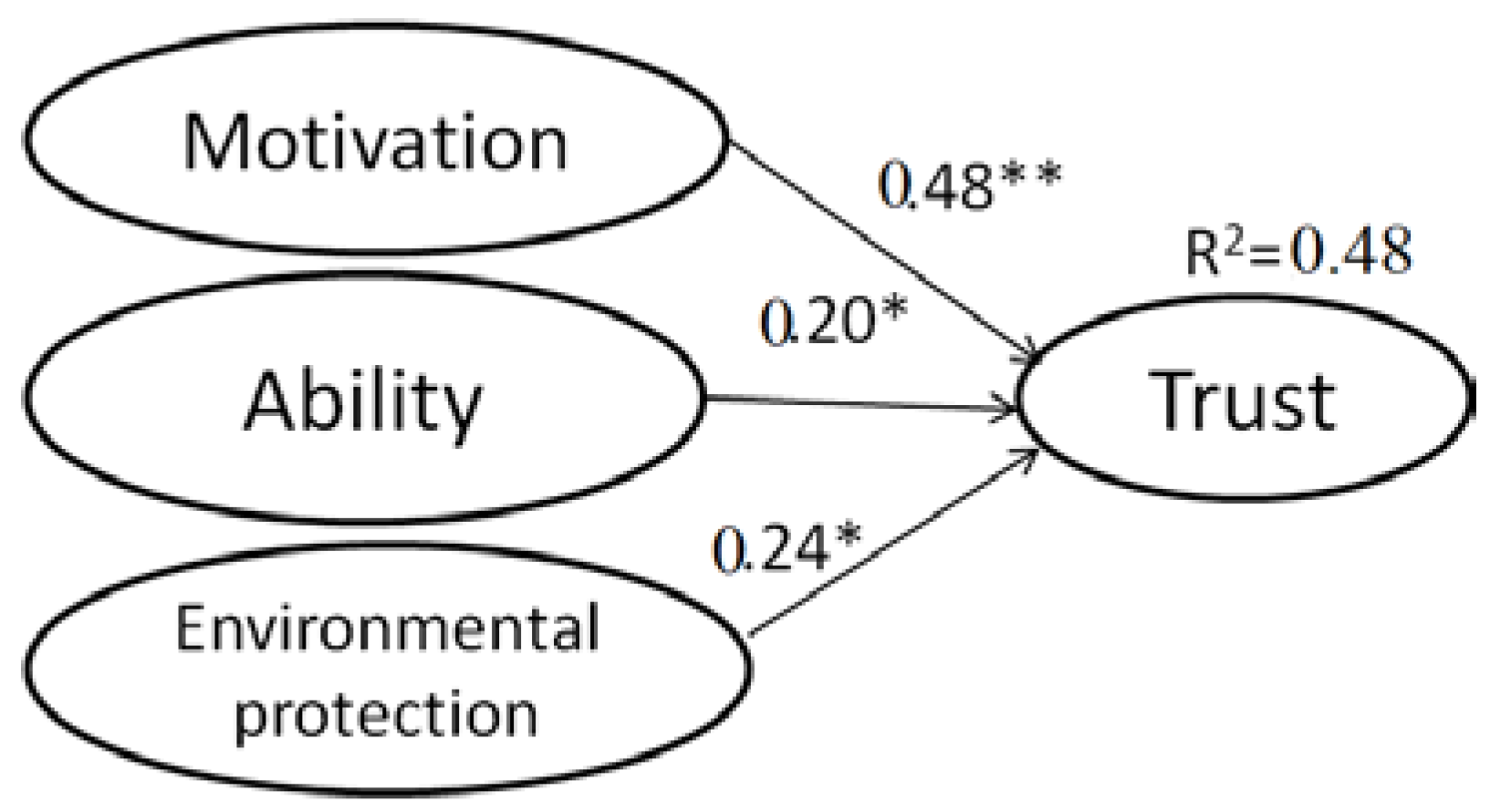Effect of Local Community’s Environmental Perception on Trust in a Mining Company: A Case Study in Mongolia
Abstract
:1. Introduction
2. Theories of Trust
2.1. The Determinants of Trust
2.2. Salient Value Similarity (SVS) in this Study
3. Methods
3.1. Study Area and Respondents
3.2. Questionnaire
3.2.1. Qualitative Data of the Open-Ended Questions
- To define SVS for this case study, the question “What does the mining company need to consider carrying out a long-time mining operation?” was used. The respondents were instructed to list up to three answers in the order of importance. The first out of the three answers were selected and analysed, yielding the total number of 46 answers.
- To reveal and discuss the respondents’ opinions about the company, the question “What is your opinion about the mining company and its activities?” was used. The responses were collected from 37 participants (herders residing close n = 15, other herders n = 8, and town citizens n = 14).
3.2.2. Quantitative Data
- Trust
- 1.
- “Residents respect the company.”
- 2.
- “Residents rely on the company.”
- Motivation
- 3.
- “The company is very conscious about the issues related to residents.”
- 4.
- “The company treats all problems fairly.”
- Ability
- 5.
- “The mining operation and mineral processing follows the appropriate technological regimes using modern equipment and machinery.”
- 6.
- “Workers in the mining company are highly skilled.”
- The company’s effort to protect environment (Environmental protection)
- 7.
- “The company is serious about environmental problems.”
- 8.
- “The company conducts environmental monitoring and controls contamination.”
4. Results and Discussion
4.1. Reliability Coefficients
4.2. Determinants of Trust
4.3. Trust Level Differences between the Respondent Groups
4.4. Relation between Trust and the Determinants for Each Respondent Group
4.5. Results of the Open-Ended Question and Discussion
4.5.1. Defining Salient Value of the Respondents
4.5.2. Positive Perceptions
4.5.3. Perceptions of Negative Environmental Effects
There was a beautiful hill, but now it has been ruined (Respondents: 2 herders residing close). The mining operation greatly damaged the natural environment (Respondents: 2 herders residing close, 1 other herder). The seven lakes have been dug in the [open] pit mine, which cannot be filled back, even after the rehabilitation is finished (Respondents: 3 herders residing close, 1 other herder).
The waste water with cyanide in this lake [the tailings dam] may be penetrating and polluting ground water (Respondents: 2 herders residing close). The mine uses a lot of ground water through many ground water wells. Now soil in the pasture land has become dry (Respondents: 4 herders residing close).
The mine was there for too short; it provided no benefit to the country/local area (Respondents: 3 herders residing close, 1 other herder). The company dug tens of tons of gold but nothing has changed for us (1 herder residing close).
4.5.4. Far from the Mine Site
5. Information Communicability
6. Conclusions and Recommendations for Mining Companies
Acknowledgments
Author Contributions
Conflicts of Interest
References
- Conde, M.; Le Billon, P. Why do some communities resist mining projects while others do not? Extr. Ind. Soc. 2017, 4, 681–697. [Google Scholar] [CrossRef]
- Temper, L.; del Bene, D.; Martinez-Alier, J. Environmental Justice Atlas. Available online: https://ejatlas.org/ (accessed on 10 August 2017).
- Dougherty, M.L.; Olsen, T.D. They have good devices: Trust, mining, and the microsociology of environmental decision-making. J. Clean. Prod. 2014, 84, 183–192. [Google Scholar] [CrossRef]
- Bebbington, A.; Williams, M. Water and Mining Conflicts in Peru. Mt. Res. Dev. 2008, 28, 190–195. [Google Scholar] [CrossRef]
- Dalaibuyan, B. Mobilizing against Dispossession: Gold Mining and a Local Resistance Movement in Mongolia. J. Cent. North. Humanit. 2012, 5, 13–32. [Google Scholar]
- Beck, L.; Mendel, T.; Thindwa, J. The Enabling Environment for Social Accountability in Mongolia; Report; World Bank: Washington, DC, USA, 2007. [Google Scholar]
- Reeves, J. Mongolia’s Environmental Security. Asian Surv. 2011, 51, 453–471. [Google Scholar] [CrossRef]
- Moffat, K.; Zhang, A. The paths to social licence to operate: An integrative model explaining community acceptance of mining. Resour. Policy 2014, 39, 61–70. [Google Scholar] [CrossRef]
- Möllering, G.; Bachmann, R.; Hee Lee, S. Introduction: Understanding organizational trust-foundations, constellations, and issues of operationalisation. J. Manag. Psychol. 2004, 19, 556–570. [Google Scholar] [CrossRef]
- Jigjid, R.; The Minister of Mineral Resources Mongolia. Speech at a Conference of “Geology and Exploration in Mongolia-2016.” on 4 March 2016. Available online: https://www.infomongol.mn/content/print/67483.htm (accessed on 9 September 2016).
- Tumurtogoo, E. Food Demand and Supply of Mongolia. Available online: http://www.nodai.ac.jp/cip/iss/english/9th_iss/fullpaper/1-2-4msua-enkhbayar.pdf (accessed on 13 October 2017).
- Sharma, V.; Dalaibuyan, B.; Erdenebileg, G.-O.; Natsag, M.; Adiya, S. Traditional Livelihoods and Mining in Mongolia’s Changing Climate: Exploring the Potential of Cross-sectoral Partnerships in Achieving Sustainability. APN 2016, 6, 8–12. [Google Scholar] [CrossRef]
- Cane, I.; Schleger, A.; Ali, S.; Kemp, D.; McIntyre, N.; McKenna, P.; Lechner, A.; Dalaibuyan, B.; Lahiri-Dutt, K.; Bulovic, N. Responsible Mining in Mongolia: Enhancing Positive Engagement; Report; Sustainable Minerals Institute, The University of Queensland: Brisbane, Australia, 2015. [Google Scholar]
- Interview with a manager of the mining company (Ulaanbaatar, Mongolia). Personal communication, 2013.
- Norton, B.G.; Steinemann, A.C. Environmental values and adaptive management. Environ. Values 2001, 10, 473–506. [Google Scholar] [CrossRef]
- Brody, S.D.; Highfield, W.; Peck, B.M. Exploring the mosaic of perceptions for water quality across watersheds in San Antonio, Texas. Landsc. Urban Plan. 2005, 73, 200–214. [Google Scholar] [CrossRef]
- Brody, S.D.; Highfield, W.; Alston, L. Does location matter? Measuring environmental perceptions of creeks in two San Antonio watersheds. Environ. Behav. 2004, 36, 229–250. [Google Scholar] [CrossRef]
- Barber, B. The Logic and Limits of Trust; Rutgers University Press: New Brunswick, NJ, USA, 1983; pp. 9–15. ISBN 0-8135-0958. [Google Scholar]
- Mollering, G. Trust: Reason, Routine, Reflixivity, 1st ed.; Elsevier Ltd.: Oxford, UK, 2006; ISBN 978-0-08-044855-8. [Google Scholar]
- Horowitz, L.S. “Twenty years is yesterday”: Science, multinational mining, and the political ecology of trust in New Caledonia. Geoforum 2010, 41, 617–626. [Google Scholar] [CrossRef]
- Peters, R.G.; Covello, V.T.; McCallum, D.B. The Determinants of Trust and Credibility in Environmental Risk Communication: An Empirical Study. Risk Anal. 1997, 17, 43–54. [Google Scholar] [CrossRef] [PubMed]
- Nakayachi, K.; Kudo, D.; Ozaki, T. Trust in organizations conserned with risks of the Great East Japan Earthquake. Jpn. J. Psychol. 2014, 85, 139–147. [Google Scholar] [CrossRef]
- Renn, O.; Levine, D. Credibility and trust in risk communication. In Communicating Risks to the Public; Springer: Dordrecht, The Netherlands, 1991; pp. 175–218. [Google Scholar]
- Hovland, I.; Janis, L.; Kelley, H. Communication and Persuasion, 13th ed.; Yale University Press Ltd.: London, UK, 1953; p. 21. ISBN 0-300-00573-3. [Google Scholar]
- Möllering, G. Rational, Institutional and Active Trust: Just Do It!? In Trust under Pressure: Empirical Investigations of Trust and Trust Building in Uncertain Circumstances; Edawad Elgar: Cheltenham, UK, 2005; pp. 17–36. [Google Scholar]
- Earle, T.; Cvetkovich, G. Social Trust: Toward a Cosmopolitan Society; Greenwood Publishing Group: Santa Barbara, CA, USA, 1995; ISBN 978-0275948450. [Google Scholar]
- Siegrist, M.; Cvetkovich, G.T.; Gutscher, H. Shared values, social trust, and the perception of geographic cancer clusters. Risk Anal. 2001, 21, 1047–1053. [Google Scholar] [CrossRef] [PubMed]
- Saldana, J. The Coding Manual for Qualitative Researchers; SAGE Publications Inc.: London, UK, 2009; pp. 66–77. ISBN 978-1-84787-548-8. [Google Scholar]
- Likert, R. A Technique for the Measurement of Attitudes. Available online: https://legacy.voteview.com/pdf/Likert_1932.pdf (accessed on 5 August 2017).
- Sato, K.; Ohnuma, S. Influence of involvement and interest over determinants of trust in authority in public decision-making. J. Jpn. J. Soc. Psychol. 2013, 29, 94–103. [Google Scholar] [CrossRef]
- Cronbach, L.J. Coefficient alpha and the internal structure of tests. Psychometrika 1951, 16, 297–334. [Google Scholar] [CrossRef]
- Atsushi, O. Analysis of Psychological Survey Data by SPSS and AMOS; Tokyo Tosho: Tokyo, Japan, 2004; ISBN 978-4-489-00675-3. [Google Scholar]
- Soini, K.; Vaarala, H.; Pouta, E. Residents’ sense of place and landscape perceptions at the rural-urban interface. Landsc. Urban Plan. 2012, 104, 124–134. [Google Scholar] [CrossRef]
- Lewis, J.D.; Weigert, A. Trust as a Social Reality. Soc. Forces 1985, 63, 967–985. [Google Scholar] [CrossRef]
- Luhmann, N. Familiarity, Confidence, Trust: Problems and Alternatives. In Trust: Making and Breaking Cooperative Relations; Basil Blackwell: Oxford, UK, 2000; pp. 94–107. [Google Scholar] [CrossRef]
- Representative of the mining company in a town (Selenge, Mongolia). Personal communication, Interview. 2013.
- Bebbington, A.J.; Bury, J.T. Institutional challenges for mining and sustainability in Peru. Proc. Natl. Acad. Sci. USA 2009, 106, 17296–17301. [Google Scholar] [CrossRef] [PubMed]
- Lawson, K. Communities, Building Trust between Mining Companies and Communities. Available online: https://www.csiro.au/en/Research/MRF/Areas/Community-and-environment/reflexivity (accessed on 3 December 2017).
- Nakayachi, K. Safe, but Cannot Be Relieved: Psychology over Trust; Chukuma Shimpo Publishing: Tokyo, Japan, 2008. [Google Scholar]
- Prno, J.; Scott Slocombe, D. Exploring the origins of “Social license to operate” in the mining sector: Perspectives from governance and sustainability theories. Resour. Policy 2012, 37, 346–357. [Google Scholar] [CrossRef]
- Moffat, K.; Zhang, A.; Boughen, N. Australian Attitudes toward Mining: Citizen Survey—2014 Results; CSIRO: Canberra, Australia, 2014; pp. 1–16. [Google Scholar]


| Respondent Groups | Number of Responses | Locations of Residence |
|---|---|---|
| Town citizens | 35 | In the central towns of soums, far from the mine site |
| Herders, residing close to the mine site (abbreviated as “herders residing close”) | 17 | In the proximity to the mine site |
| Other herders | 19 | Within the territories of the soums, far from the mine site |
| Items | Ability | Motivation | Environmental Protection | Trust |
|---|---|---|---|---|
| Respondent Groups | Mean (SD) | Mean (SD) | Mean SD | Mean SD |
| Herders residing close | 3.97 (1.01) | 2.82 (1.22) | 3.15 (1.27) | 3.15 (1.27) |
| Other herders | 3.95 (0.72) | 3.45 (1.05) | 3.37 (1.04) | 3.63 (1.12) |
| Town citizens | 3.87 (0.98) | 3.34 (1.20) | 3.54 (1.26) | 4.06 (0.94) |
| Respondent Groups | Items | Ability | Motivation | Environmental Protection |
|---|---|---|---|---|
| Herder close | Trust | 0.70 ** | 0.82 ** | 0.64 ** |
| Other herders | Trust | 0.33 | 0.32 | 0.43 |
| Town citizens | Trust | 0.06 | 0.62 ** | 0.50 ** |
| Codes | Samples of Answers | Number of Responses |
|---|---|---|
| A. No environmental contamination and good quality rehabilitation | Do not cause contamination of the natural environment | n = 28 |
| Good quality rehabilitation to be conducted in the mined land | ||
| B. Contribution to the local area development | The mining company has to support the local area financially | n = 13 |
© 2018 by the authors. Licensee MDPI, Basel, Switzerland. This article is an open access article distributed under the terms and conditions of the Creative Commons Attribution (CC BY) license (http://creativecommons.org/licenses/by/4.0/).
Share and Cite
Dagvadorj, L.; Byamba, B.; Ishikawa, M. Effect of Local Community’s Environmental Perception on Trust in a Mining Company: A Case Study in Mongolia. Sustainability 2018, 10, 614. https://doi.org/10.3390/su10030614
Dagvadorj L, Byamba B, Ishikawa M. Effect of Local Community’s Environmental Perception on Trust in a Mining Company: A Case Study in Mongolia. Sustainability. 2018; 10(3):614. https://doi.org/10.3390/su10030614
Chicago/Turabian StyleDagvadorj, Lavdmaa, Bolorchimeg Byamba, and Mamoru Ishikawa. 2018. "Effect of Local Community’s Environmental Perception on Trust in a Mining Company: A Case Study in Mongolia" Sustainability 10, no. 3: 614. https://doi.org/10.3390/su10030614




